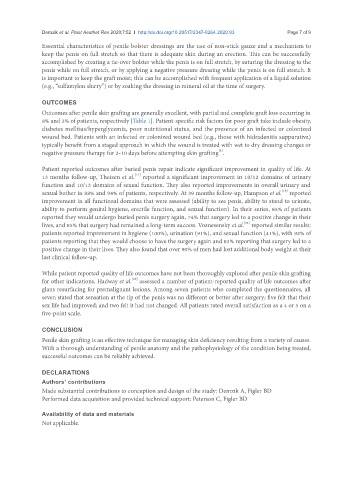Page 606 - Read Online
P. 606
Demzik et al. Plast Aesthet Res 2020;7:52 I http://dx.doi.org/10.20517/2347-9264.2020.93 Page 7 of 9
Essential characteristics of penile bolster dressings are the use of non-stick gauze and a mechanism to
keep the penis on full stretch so that there is adequate skin during an erection. This can be successfully
accomplished by creating a tie-over bolster while the penis is on full stretch, by suturing the dressing to the
penis while on full stretch, or by applying a negative pressure dressing while the penis is on full stretch. It
is important to keep the graft moist; this can be accomplished with frequent application of a liquid solution
(e.g., “sulfamylon slurry”) or by soaking the dressing in mineral oil at the time of surgery.
OUTCOMES
Outcomes after penile skin grafting are generally excellent, with partial and complete graft loss occurring in
8% and 3% of patients, respectively [Table 1]. Patient-specific risk factors for poor graft take include obesity,
diabetes mellitus/hyperglycemia, poor nutritional status, and the presence of an infected or colonized
wound bed. Patients with an infected or colonized wound bed (e.g., those with hidradenitis suppurativa)
typically benefit from a staged approach in which the wound is treated with wet to dry dressing changes or
[5]
negative pressure therapy for 3-10 days before attempting skin grafting .
Patient reported outcomes after buried penis repair indicate significant improvement in quality of life. At
[14]
13 months follow-up, Theisen et al. reported a significant improvement in 10/12 domains of urinary
function and 10/13 domains of sexual function. They also reported improvements in overall urinary and
sexual bother in 88% and 94% of patients, respectively. At 39 months follow-up, Hampson et al. reported
[19]
improvement in all functional domains that were assessed (ability to see penis, ability to stand to urinate,
ability to perform genital hygiene, erectile function, and sexual function). In their series, 85% of patients
reported they would undergo buried penis surgery again, 74% that surgery led to a positive change in their
lives, and 85% that surgery had remained a long-term success. Voznesensky et al. reported similar results:
[11]
patients reported improvement in hygiene (100%), urination (91%), and sexual function (41%), with 92% of
patients reporting that they would choose to have the surgery again and 83% reporting that surgery led to a
positive change in their lives. They also found that over 90% of men had lost additional body weight at their
last clinical follow-up.
While patient reported quality of life outcomes have not been thoroughly explored after penile skin grafting
[20]
for other indications, Hadway et al. assessed a number of patient-reported quality of life outcomes after
glans resurfacing for premalignant lesions. Among seven patients who completed the questionnaires, all
seven stated that sensation at the tip of the penis was no different or better after surgery; five felt that their
sex life had improved; and two felt it had not changed. All patients rated overall satisfaction as a 4 or 5 on a
five-point scale.
CONCLUSION
Penile skin grafting is an effective technique for managing skin deficiency resulting from a variety of causes.
With a thorough understanding of penile anatomy and the pathophysiology of the condition being treated,
successful outcomes can be reliably achieved.
DECLARATIONS
Authors’ contributions
Made substantial contributions to conception and design of the study: Demzik A, Figler BD
Performed data acquisition and provided technical support: Peterson C, Figler BD
Availability of data and materials
Not applicable.

